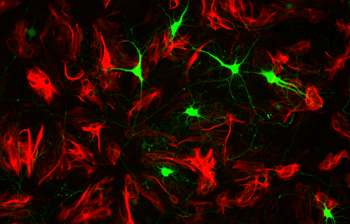Helper cells in the brain could hold the clue to motor neuron disease

Helper cells in the brain, which support nerve function, change their behaviour with the progression of motor neuron disease (MND), a new study has found.
Researchers at the Sheffield Institute for Translational Neuroscience (SITraN) discovered the star-shaped cells, called astrocytes, progressively lose the ability to support motor neurons as MND progresses leading to the death of the specialised nerve cells that control our movements.
The pioneering study revealed the full extent of astrocyte behaviour in a mouse model of MND from pre-symptomatic to late stages of the disease.
Co-lead of the study, Dr Janine Kirby, Senior Lecturer in Neurogenetics at the University of Sheffield, said: "Overall, our data suggest that astrocytes react to disease by engaging damage limitation strategies including clearing debris and waste from the motor neurons and redistributing components such as cholesterol, which is crucial for nerve cell function.
"However, as the disease progresses, astrocytes lose their supportive functions and the ability to control their external environment which ultimately leads to the death of the motor neurons."
Astrocytes are key players in the progression of MND and other neurodegenerative diseases such as Alzheimer's disease. They have many important supportive functions and are critical for the proper functioning and survival of nerve cells.
In order to provide the first detailed map of astrocyte behaviour throughout the disease course, researcher and study co-author Dr David Baker investigated differences in gene expression in astrocytes in a well-characterised mouse model of MND which carries the SOD1G93A mutation. The team confirmed their findings with further enzymatic essays and in vitro experiments.
One of the senior researchers of this study, Marie Curie Research Fellow Dr Laura Ferraiuolo, and the team at SITraN have previously shown that astrocytes at the pre-symptomatic stage are known to lose some supportive functions to motor neurons seen in the decreased provision of growth factors as well as lactate needed to generate energy.
The new data shows that as the disease progresses and symptoms occur, SOD1 astrocytes transition into an activated state.
The reactive astrocytes show an altered stress and immune response compared to their healthy counterparts.
Waste processing and recycling is increased through the activation of lysosomal and phagocytic pathways, most likely to protect nerve cells from the accumulation of cell debris which can cause inflammation and lead to cell death (apoptosis).
The late stage shows additional changes in cholesterol production and distribution which is also critical for neuron survival.
Clinician Scientist in Neurology and MND specialist Professor Dame Pam Shaw, Director of SITraN and co-lead of this study, said: "Taken together, SOD1G93A astrocytes are characterized by a loss of supportive function towards motor neurons, as well as acquiring toxic properties during the disease course, and these factors in the neighbourhood of motor neurons compromise the health and survival of the nerve cells.
"The next step will be to determine whether astrocyte behaviour can be modulated or even restored, and whether this is a means by which to slow down disease progression in MND."
More information: David J. Baker et al. Lysosomal and phagocytic activity is increased in astrocytes during disease progression in the SOD1 G93A mouse model of amyotrophic lateral sclerosis, Frontiers in Cellular Neuroscience (2015). DOI: 10.3389/fncel.2015.00410

















